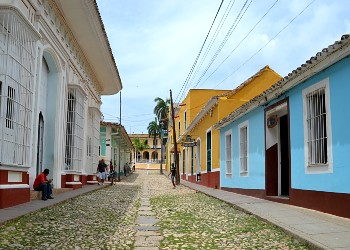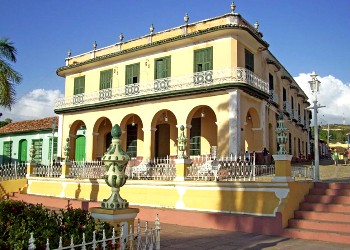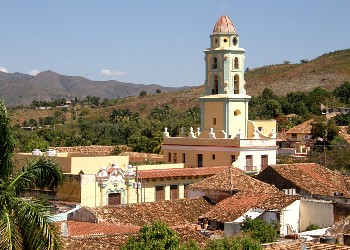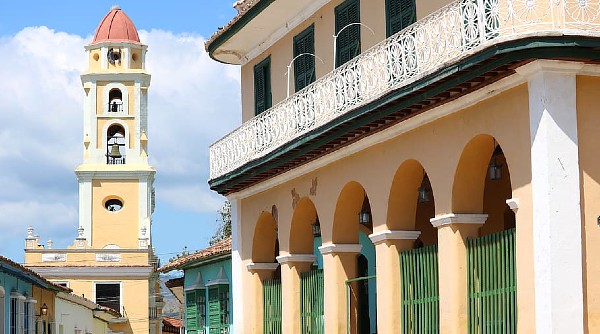The Caribbean island of Cuba is filled with history and destinations with stories to tell. Among the most well preserved is the town of Trinidad, located on the country’s south-central coast and known for its colonial structures, cobblestone streets, and neo-baroque main square.
Trinidad dates back to 1514 when the region was discovered by Spanish conquistador Diego Velázquez de Cuéllar. Nowadays, Trinidad’s main industry is tobacco processing. However, in the 1800s, the town was a major hub of the sugar trade. The lucrative business yielded a fortune and allowed for the construction of palatial estates and extravagant plazas and churches, all of which can still be seen today. To that point, Trinidad was listed on UNESCO’s list of World Heritage Sites in 1988 together with nearby Valle de Los Ingenios (Valley of the Sugar Mills).

Pastel Colored Houses
Because Trinidad is not the type of Cuban tourist hub that is seen in Havana, Varadero, and Holguin, visitors can expect a quiet and easygoing town that offers a picturesque setting with the Escambray Mountains as a backdrop.
Pastel-painted buildings add a splash of color to the town, typically seen throughout the Caribbean, and historical landmarks are strewn throughout.
Trinidad occupies a region of 165 square miles and is divided into barrios (quarters). Fortunately, the historic area that tourists are most likely to visit is small and easily walkable, with most attractions mere steps from one another.
Start at the main square — Plaza Mayor, which is located in the heart of the historic center and is festooned with royal palm trees. From there, explore Iglesia de la Santísima, the 19th-century Catholic church.

Museo Romántico
Marvel at the yellow stucco estate, which was once known as Palacio Brunet and was owned by Trinidad’s wealthiest families. Nowadays, the building is repurposed and renamed as Museo Romántico and acts as a museum that houses furnishings and other items of interest that once belonged to well-to-do residents.
Next, discover the antiques of Palacio Cantero’s Museo de Historia Municipal (Municipal Museum of History) featuring unique neoclassical architecture, murals, and a central courtyard. And, if you’re looking to take beautiful photos, don’t forget to climb up the lookout tower for stunning views of Trinidad and all the natural beauty that lies just beyond.
For more panoramic views, head to the Convento de San Francisco and climb the bell tower. This building was previously used as a convent but now contains the Museo Nacional de Lucha Contra Bandidos (National Museum of the Struggle Against Bandits).

Convento de San Francisco
Just like in Havana, visitors will find an abundance of classic cars here, as well as horses and carts in the streets.
Travelers will also find a lively music scene. By day, small local groups can be seen sitting together and playing for donations in and around the touristy area. By night, a variety of Cuban bands can be found playing the outdoor stage at Casa de la Música. This is a great way to relax and immerse in the culture after a long day of sightseeing.
As a refreshment, order a Cerveza (beer), particularly Cristal, which is an authentic Cuban brew that is light on alcohol content. Or try one of Cuba’s signature cocktails — a Mojito made with rum, sparkling water, sugar, lemon juice, ice, and mint; a Cuba Libre made with a blend of rum and cola, or a Cuban Ginger made with apple liquor and alcoholic Ginger Ale. Or try a drink created specifically in Trinidad — a Canchánchara made with rum, honey, and tart lime juice. Legend has it that the drink was invented in the 19th century by the Cuban guerrillas that battled against the Spanish during the Ten Years’ War.

Playa Ancon
If you’re looking to cool off and desire scenery of a different kind, escape to one of Cuba’s best but lesser-known beaches — Playa Ancón. Located approximately 15 minutes from Trinidad, travelers can get to the beach via bus or taxi.
More serene than most beaches on the island, visitors can enjoy a wide stretch of fine white sand and turquoise waters. There are a few beachfront resorts in the vicinity, but they are grouped together and relatively quiet, and its easy to venture further down the beach for a more secluded spot. And if you get hungry, you can simply stroll back to them to grab a bite.
For a different kind of adventure, visit Topes de Collantes National Park, located approximately 25 minutes from Trinidad’s main square. This beautiful national park is a nature reserve located in the Escambray Mountains and offers visitors the opportunity to hike, enjoy a horseback tour, or swim in the scenic waterfalls.
All photos via Pixabay


